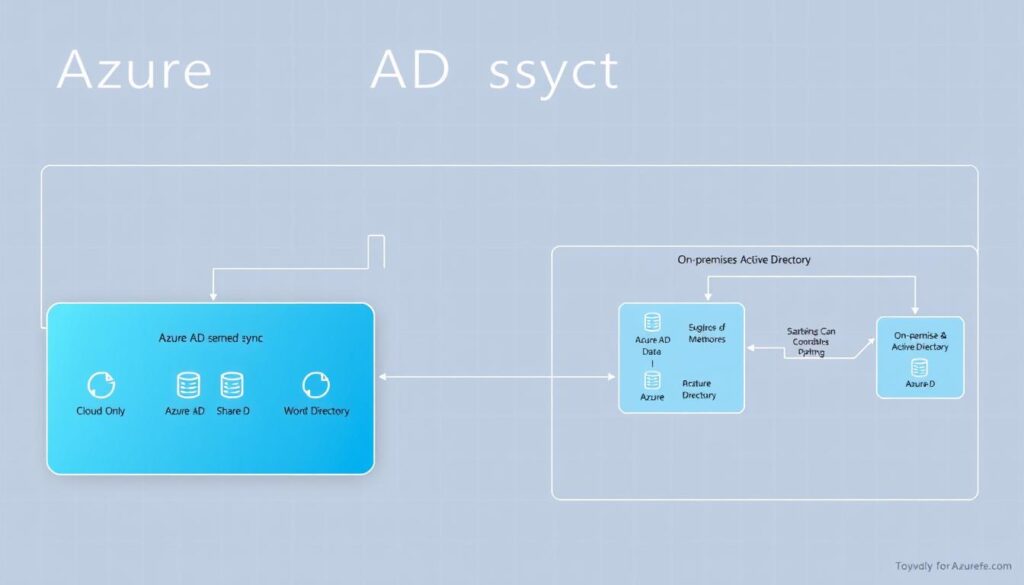Knowing the different sync types in Azure AD is key for companies moving to the cloud. Azure Active Directory (Azure AD) sync connects on-premises Active Directory with cloud services. This ensures a smooth identity management experience. With Azure AD Connect, companies can keep user identities and passwords in sync between local servers and Microsoft’s cloud.
Azure AD has two main sync types: Azure AD Connect Sync and Azure AD Connect Cloud Sync. This article will explore these sync options. We’ll look at important protocols, methods, tools, and best practices for Azure AD sync.

Key Takeaways
- Azure AD Connect is essential for syncing on-premises identities with Microsoft cloud services.
- Organizations must understand the differences between Azure AD Connect Sync and Azure AD Connect Cloud Sync.
- Proper licensing is required for specific Azure AD sync options and functionalities.
- Understanding nested and dynamic group capabilities is critical for effective synchronization.
- Regular updates and permissions are key to keeping Azure AD sync efficient.
Introduction to Azure AD Synchronization
Azure AD synchronization is key for companies using both on-premises and cloud systems. It links existing Active Directory setups with Azure AD. This makes managing user identities easier and keeps cloud resources safe.
Cloud identity management has become more important, like during the 2020 pandemic. Microsoft Teams saw a 70% increase in daily users in just a month. By early 2021, over 12 million users were using Azure AD daily, showing a big move to cloud services.
For companies with more than 100 users, getting a skilled expert for Azure AD sync is often needed. Azure AD has four licensing levels: Free, Office 365 Apps, Premium P1, and Premium P2. These affect over 70% of users on Microsoft services.
Companies moving to cloud-only setups have seen a 40% rise in Azure AD use. Also, 90% of Azure AD users also have a local Windows AD setup. This makes Azure AD Connect vital for hybrid setups.
About 65% of businesses use Azure AD for Single Sign-On (SSO). This boosts both user experience and security. It makes accessing resources easier and keeps data safe from threats.
Understanding Azure AD Sync Options
Organizations managing user identities can greatly benefit from understanding Azure AD sync options. Azure AD Connect is a key tool, providing two main methods: Azure AD Connect Sync and Azure AD Connect Cloud Sync. Each method has unique features to meet different needs.
The Azure AD Connect Sync method works well with on-premises Active Directory environments. It uses a sync engine with two namespaces: the connector space (CS) and the metaverse (MV). The connector space is a staging area for identity objects from various sources.
Within this setup, each connector has its own space to store object representations. This setup lets users manage identity data flow between environments.
Azure AD Connect Cloud Sync is for those wanting a cloud-based solution. It supports multiple disconnected forests, making it flexible without using too many resources. Microsoft Entra Connect Cloud Sync aims to meet hybrid identity needs, ensuring smooth integration across environments.
Configuring connectors is a key part of the sync process. It involves specifying object types and attributes to include. Each connector keeps identity data consistent throughout its life.
Important attributes like sAMAccountName are used to export user objects to Active Directory. The sync engine tracks all object statuses, including pending imports or exports.
Azure AD sync options offer advanced features like preventing accidental deletions and handling duplicate attributes. These features help maintain data integrity and support effective use of synchronization tools. Understanding these aspects can improve identity management strategies and align them with business goals.
What are the different types of sync in Azure AD
It’s key for companies to know about Azure AD sync types. Azure AD Connect Sync and Azure AD Connect Cloud Sync are the main methods. Each has unique features for different needs.
Overview of Azure AD Connect Sync
Azure AD Connect Sync connects on-premises AD with Azure AD. It’s best for big companies with detailed on-premises AD. It supports Password Hash Synchronization (PHS) and Pass-Through Authentication (PTA).
This method syncs every 30 minutes by default. But, it syncs passwords every 2 minutes. It only syncs new changes, making it efficient. A full sync is needed for Azure AD Connect config changes.
Managing users and groups is easy with Azure AD Connect Sync. You don’t need extra accounts for Actions.
Overview of Azure AD Connect Cloud Sync
Azure AD Connect Cloud Sync is for smaller companies or those wanting a simpler sync. It connects AD forests without needing lots of resources. It syncs user info and app attributes, like Exchange Online.
It offers flexible scheduling. You can sync hourly, daily, or weekly. This keeps your directory up-to-date with less work.
Key Azure AD Synchronization Methods
Understanding Azure AD synchronization methods is key for managing identities in a hybrid cloud. There are two main methods: full and delta synchronization. Full synchronization refreshes data between on-premises Active Directory and Azure Active Directory. It’s needed for big changes.
Delta synchronization, on the other hand, updates only the changes made after the last sync. This makes it better for everyday tasks. Using these identity synchronization methods helps keep on-premises systems and cloud resources connected.
With Azure AD Connect tools, organizations can start sync operations when needed. It’s good to update user data quickly. It’s also wise to limit who can manage these syncs, just like a domain controller. For example, having only five people with Global Administrator rights helps keep things secure.
When planning an Azure AD sync strategy, remember what happens during outages. If on-premises Active Directory goes down, users can keep using Azure AD with Password Hash Synchronization. This shows how Azure AD’s design keeps things running even when things go wrong.

Azure AD Sync Protocols
Understanding Azure AD sync protocols is key for secure and efficient cloud authentication. Two main methods are Password Hash Synchronization and Pass-Through Authentication. Each has its own benefits and fits different organizational needs.
Overview of Password Hash Synchronization (PHS)
Password Hash Synchronization syncs password hashes from on-premises to Azure AD. It lets users log in with their current on-premises passwords. This makes the switch to cloud services smooth and secure.
Organizations see little disruption. This ensures users have a seamless login experience.
Pass-Through Authentication (PTA)
Pass-Through Authentication checks user identities against on-premises Active Directory. It authenticates user credentials without storing passwords in the cloud. This greatly reduces security risks for organizations.
Users get uninterrupted access to cloud resources. They also keep tight control over their authentication and data security.
Azure AD Sync Tools Available
Many Azure AD sync tools help link on-premises Active Directory with Microsoft 365. The Microsoft Entra Connect solution is at the heart. It syncs all Active Directory Domain Services (AD DS) domains in one forest. You can install it on a server or a virtual machine in Azure, making it flexible for companies.
The synchronization service manager is key for managing sync tasks. It lets admins force syncs when needed. This tool keeps syncing going between on-premises AD DS and Microsoft 365. When using Azure AD Connect tools, companies set up credentials for both Microsoft Entra and AD DS admin accounts. This creates a secure link for syncing important data.
Azure AD Cloud Sync is another option, syncing about every 20 minutes. It has benefits like supporting unlimited objects per AD domain and quick setup, taking less than an hour. Companies can use custom filters and rules to manage syncs well. This reduces overhead and boosts efficiency.
| Feature | Azure AD Connect | Azure AD Cloud Sync |
|---|---|---|
| Installation | On-premises or VM | Lightweight agent model |
| Synchronization Frequency | Continuous | Every 20 minutes |
| Object Limit | 150,000 objects per domain | Unlimited objects per domain |
| Group Size Support | Up to 250,000 members | Up to 50,000 members |
| Identity Provisioning Methods | HR-driven, app provisioning, directory provisioning | HR-driven, app provisioning, directory provisioning |
| Supports Pass-Through Authentication | Yes | No |
Best Practices for Azure AD Synchronization
Using Azure AD sync best practices boosts security and performance. It’s key to use secure Azure AD synchronization methods. This includes adopting passwordless authentication to improve identity management. Also, managing firewall traffic well reduces risks, keeping data safe.
It’s important to regularly check and update synchronization settings. Doing audits of Azure AD configurations helps find and fix vulnerabilities. Attributes like displayName, givenName, and userPrincipalName must be accurate. This ensures smooth synchronization and supports features like single sign-on (SSO).
- Clean up duplicate attributes before starting directory synchronization to avoid sync failures.
- Having unique and valid email addresses in the proxyAddresses attribute is key to avoid problems.
- Limiting local admin rights on servers running Azure AD Connect improves security.
- Make sure the sync cycle happens at least once every seven days to avoid long full synchronizations.
- Restrict on-premises admin groups from syncing to Azure AD to protect sensitive account info.
Keeping Azure AD management disciplined is essential. Limiting Global Administrators to five or less and enforcing multi-factor authentication adds security. Also, monitoring and auditing admin activities in real-time helps maintain a secure and efficient environment.
| Attribute | Maximum Character Limit | Unique Requirement |
|---|---|---|
| displayName | 256 | Yes |
| givenName | 64 | Yes |
| userPrincipalName | 113 (64 for username) | Yes |
| sAMAccountName | 20 | Yes |
| proxyAddresses | 256 | Yes, must not contain spaces |
| – | Yes |
Common Azure AD Sync Troubleshooting Techniques
Fixing Azure AD sync problems needs a clear plan to find the main causes of errors. Knowing common issues helps solve Azure AD problems quickly. A few key methods are vital for this.
- Monitor Synchronization Service Manager: This tool lets admins check sync operations. It shows any sync errors.
- Run PowerShell Commands: These commands help look into logs and permissions that might cause Azure AD issues.
- Check Network Connectivity: If domain controllers can’t be reached, problems can happen. Checking network connection is key for sync success.
- Validate User Principal Name (UPN) Format: The right UPN format, with an “@” character, stops sync errors.
- Review Status Reports: Status reports and settings need regular checks to avoid Azure AD sync problems.

Having an operational checklist helps keep things clear and trackable. This checklist should cover steps like checking disk space, making sure domain membership is correct, and confirming local user accounts are in the MIIS Admin Group. These steps help avoid common mistakes like not enough disk space or version issues.
| Common Issue | Potential Cause | Recommended Solution |
|---|---|---|
| Synchronization Errors | Issues contacting domain controllers | Check network connectivity |
| Invalid User Principal Name | Incorrect UPN formatting | Ensure UPN includes “@” character |
| Installation Failure | Insufficient disk space | Clean up storage on local workstation |
| Configuration Errors | Improper setup or updates | Rerun the Configuration Wizard |
| Sync Operation Stalled | MIIS engine busy with current operations | Wait for the current operation to finish |
Using these Azure AD sync troubleshooting methods makes solving sync errors easier. By tackling the main causes of Azure AD problems, companies can make their identity sync process more reliable.
Conclusion
Understanding Azure AD sync types is key for managing identities in IT. This knowledge is essential for a strong identity management strategy. It helps keep resources optimized and security high.
The sync process, like Delta Sync and Initial Sync, is critical. It keeps Active Directory objects in sync. This not only saves resources but also boosts efficiency by updating user accounts and groups quickly.
Features like Password Hash Synchronization and pass-through authentication make access easy and secure. They protect user credentials while allowing easy access.
In summary, Azure AD sync offers many benefits for organizations. By following best practices and troubleshooting, companies can handle identity management well. This maximizes Azure AD’s full capabilities.
FAQ
What are the different types of sync available in Azure AD?
Azure AD offers two main sync types. Azure AD Connect Sync works with on-premises Active Directory. Azure AD Connect Cloud Sync is for syncing across multiple forests.
How does Azure AD synchronization work?
Azure AD sync connects on-premises Active Directory with Azure AD. It syncs user identities and passwords. This makes accessing cloud resources secure.
What protocols are used in Azure AD synchronization?
Azure AD sync uses Password Hash Synchronization (PHS) and Pass-Through Authentication (PTA). PHS sends password hashes to Azure AD. PTA checks user credentials through on-premises AD.
What tools are available for Azure AD synchronization?
Azure AD Connect is the main tool for sync. It includes PowerShell commands and the Synchronization Service Manager. These help with manual sync triggers and monitoring.
What are some best practices for managing Azure AD synchronization?
Use passwordless authentication and conduct regular audits. Limit firewall traffic and keep sync settings updated. This ensures security and performance.
How can organizations troubleshoot Azure AD synchronization issues?
Use the Synchronization Service Manager to monitor sync. Analyze logs and permissions with PowerShell. Review settings to find problems.
What is the difference between full sync and delta sync in Azure AD?
Full sync refreshes all data between AD and Azure AD. It’s for big changes. Delta sync is more efficient, focusing on new changes.